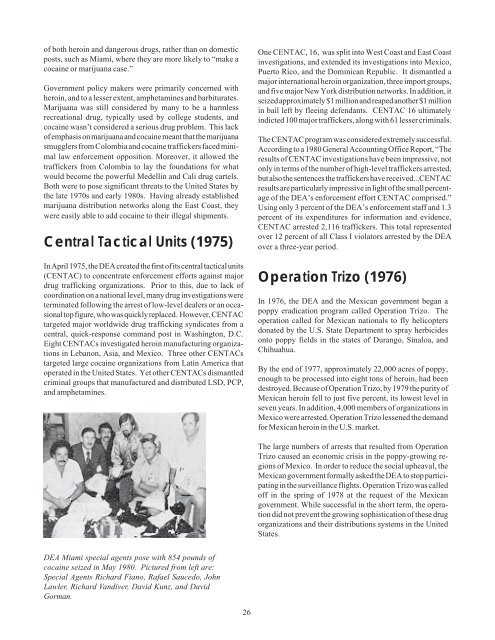Download This File - The Free Information Society
Download This File - The Free Information Society
Download This File - The Free Information Society
Create successful ePaper yourself
Turn your PDF publications into a flip-book with our unique Google optimized e-Paper software.
of both heroin and dangerous drugs, rather than on domestic<br />
posts, such as Miami, where they are more likely to “make a<br />
cocaine or marijuana case.”<br />
Government policy makers were primarily concerned with<br />
heroin, and to a lesser extent, amphetamines and barbiturates.<br />
Marijuana was still considered by many to be a harmless<br />
recreational drug, typically used by college students, and<br />
cocaine wasn’t considered a serious drug problem. <strong>This</strong> lack<br />
of emphasis on marijuana and cocaine meant that the marijuana<br />
smugglers from Colombia and cocaine traffickers faced minimal<br />
law enforcement opposition. Moreover, it allowed the<br />
traffickers from Colombia to lay the foundations for what<br />
would become the powerful Medellin and Cali drug cartels.<br />
Both were to pose significant threats to the United States by<br />
the late 1970s and early 1980s. Having already established<br />
marijuana distribution networks along the East Coast, they<br />
were easily able to add cocaine to their illegal shipments.<br />
Central Tactical Units (1975)<br />
In April 1975, the DEA created the first of its central tactical units<br />
(CENTAC) to concentrate enforcement efforts against major<br />
drug trafficking organizations. Prior to this, due to lack of<br />
coordination on a national level, many drug investigations were<br />
terminated following the arrest of low-level dealers or an occasional<br />
top figure, who was quickly replaced. However, CENTAC<br />
targeted major worldwide drug trafficking syndicates from a<br />
central, quick-response command post in Washington, D.C.<br />
Eight CENTACs investigated heroin manufacturing organizations<br />
in Lebanon, Asia, and Mexico. Three other CENTACs<br />
targeted large cocaine organizations from Latin America that<br />
operated in the United States. Yet other CENTACs dismantled<br />
criminal groups that manufactured and distributed LSD, PCP,<br />
and amphetamines.<br />
DEA Miami special agents pose with 854 pounds of<br />
cocaine seized in May 1980. Pictured from left are:<br />
Special Agents Richard Fiano, Rafael Saucedo, John<br />
Lawler, Richard Vandiver, David Kunz, and David<br />
Gorman.<br />
26<br />
One CENTAC, 16, was split into West Coast and East Coast<br />
investigations, and extended its investigations into Mexico,<br />
Puerto Rico, and the Dominican Republic. It dismantled a<br />
major international heroin organization, three import groups,<br />
and five major New York distribution networks. In addition, it<br />
seized approximately $1 million and reaped another $1 million<br />
in bail left by fleeing defendants. CENTAC 16 ultimately<br />
indicted 100 major traffickers, along with 61 lesser criminals.<br />
<strong>The</strong> CENTAC program was considered extremely successful.<br />
According to a 1980 General Accounting Office Report, “<strong>The</strong><br />
results of CENTAC investigations have been impressive, not<br />
only in terms of the number of high-level traffickers arrested,<br />
but also the sentences the traffickers have received...CENTAC<br />
results are particularly impressive in light of the small percentage<br />
of the DEA’s enforcement effort CENTAC comprised.”<br />
Using only 3 percent of the DEA’s enforcement staff and 1.3<br />
percent of its expenditures for information and evidence,<br />
CENTAC arrested 2,116 traffickers. <strong>This</strong> total represented<br />
over 12 percent of all Class I violators arrested by the DEA<br />
over a three-year period.<br />
Operation Trizo (1976)<br />
In 1976, the DEA and the Mexican government began a<br />
poppy eradication program called Operation Trizo. <strong>The</strong><br />
operation called for Mexican nationals to fly helicopters<br />
donated by the U.S. State Department to spray herbicides<br />
onto poppy fields in the states of Durango, Sinaloa, and<br />
Chihuahua.<br />
By the end of 1977, approximately 22,000 acres of poppy,<br />
enough to be processed into eight tons of heroin, had been<br />
destroyed. Because of Operation Trizo, by 1979 the purity of<br />
Mexican heroin fell to just five percent, its lowest level in<br />
seven years. In addition, 4,000 members of organizations in<br />
Mexico were arrested. Operation Trizo lessened the demand<br />
for Mexican heroin in the U.S. market.<br />
<strong>The</strong> large numbers of arrests that resulted from Operation<br />
Trizo caused an economic crisis in the poppy-growing regions<br />
of Mexico. In order to reduce the social upheaval, the<br />
Mexican government formally asked the DEA to stop participating<br />
in the surveillance flights. Operation Trizo was called<br />
off in the spring of 1978 at the request of the Mexican<br />
government. While successful in the short term, the operation<br />
did not prevent the growing sophistication of these drug<br />
organizations and their distributions systems in the United<br />
States.

















